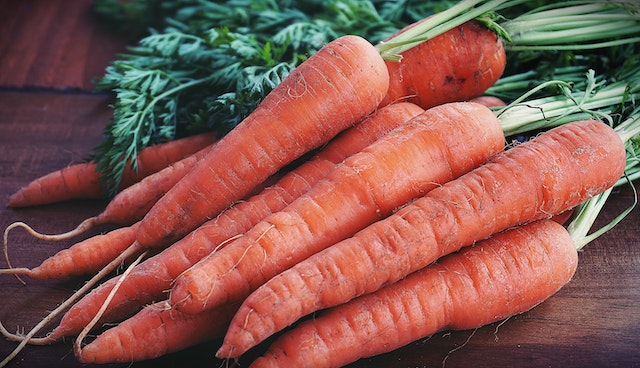
Why are carrots orange? Because they contain carotenoids, which are orange.
Carotenoids are organic pigments that are produced by plants, algae, and some bacteria and fungi. They can be found in vegetables such as pumpkins, carrots, corn, and in animals such as canaries, lobsters, and flamingoes. In plants and algae, carotenoids absorb sunlight for photosynthesis. They also protect the organism from being damaged by the same sunlight they use for photosynthesis.
So, if carotenoids are used for photosynthesis, why do carrots contain them? Carrots are root vegetables and grow under the ground where there is no sunlight, so they have no use for carotenoids. The answer to this lies in the fact that carrots have only been orange since relatively recently. Carrots were originally white, which makes sense for something that grows under the ground.
The wild carrot originated in Persia, the area that is now Iran and Afghanistan. All the varieties of carrot we have now have descended from this original carrot. When early people started to take an interest in the carrot plant, they used it just for the leaves and seeds. Carrots are related to parsley, coriander, dill, and fennel, amongst many other types of herbs that we only use for their leaves and seeds. Carrot seeds have been found in Swiss and German sites dating back 5,000 years, so there is evidence that carrots had spread, but these were still just the wild variety.
The carrot was eaten by the Romans over 2,000 years ago, but it may also have been the parsnip. The carrot that they knew was white and thin. It was used as a medicine and was thought to be a medicine to aid love-making. They used the seeds of the carrot as an antidote to certain poisons. The Romans knew that the root of the carrot plant could be cooked and eaten, but it doesn’t appear to have been a very common vegetable. This is probably because early forms of the carrot were bitter and had a very woody core.
There were many different subspecies of the wild carrot, and the one that is the ancestor of the carrot we eat today was domesticated in about the 10th century. The early carrots were brown or purple. They were also harder to chew and less sweet than modern characters. Over the centuries the people who farmed them bred them selectively to be sweeter and softer.
The first reference to a carrot being eaten as a vegetable comes from Moorish Spain in about 950 AD. By the 13th century they were being eaten in France and Germany as well and in England 100 years later. The carrots eaten in Spain were purple, but the carrots being eaten by the end of the 16th century were more often yellow. It seems that people preferred the yellow varieties and the farmers bred for them.
The orange carrot appeared in the Netherlands in the 18th century. It was called the “long orange” and it quickly became popular. A legend has grown up that the Dutch developed the orange carrot to be a tribute to the House of Orange, the Dutch royal family. Orange is not the color, but a region in what is the south of modern day France. The Dutch low countries were a Spanish colony in the late 1500s. William, Prince of Orange, appeared and led a revolt against the Spanish leaders. It took a long time, but Spain finally recognized the independence of the Dutch Republic. The Republic was soon replaced by the monarchy, the House of Orange, which still rule the country today.
The carrot legend claims that farmers began to cultivate orange carrots out of respect for William’s House of Orange. As romantic as this story is, there doesn’t appear to be any evidence to back it up. It seems far more likely that an orange carrot appeared, became popular, and the legend was applied to it, rather than the other way around.
So, why are carrots orange? The orange variety probably appeared as a mutation, but it has several advantages over the other colors of carrots, so farmers would have been keen to breed for it. The first was its color. Brown and purple carrots would have given their coloration to soups and stews, making them look fairly unattractive. The second reason is that they are better for people’s health. They have very high levels of carotenoids β-carotene, which is a great source of vitamin A. They also contain more antioxidants than other types of carrots. Farmers in the 17th and 18th centuries wouldn’t have known about this, but they may have noticed the health benefits of their carrots.
So, carrots are orange because we have selectively bred them to be orange. Naturally, carrots are white, bitter and hard to chew. And this is what I learned today.
Sources
https://books.google.co.jp/books?id=KFQMt1Ww6osC&pg=PA81&redir_esc=y#v=onepage&q&f=false
https://www.economist.com/the-economist-explains/2018/09/26/how-did-carrots-become-orange
https://en.wikipedia.org/wiki/Carotenoid
https://en.wikipedia.org/wiki/Carrot
https://www.livescience.com/why-are-carrots-orange.html
https://pubmed.ncbi.nlm.nih.gov/23876238/
https://www.alimentarium.org/en/fact-sheet/carrot
